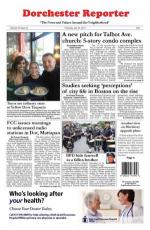May 26, 2016
Although the long-awaited Boston Creates Cultural Plan will be released officially next month, a draft of the founding document was put on line earlier this month, on May 10. Reading it has made me, and others, uneasy.
The goal of Boston Creates is to establish a long-term plan for addressing needs, identifying and taking advantage of opportunities, and deploying both existing and new resources to make Boston’s arts and cultural sector stronger.
The Boston Creates team rallied to establish the broad community engagement that was instrumental in collecting the data that went into drafting the plan. Writing the working document took over a year, with three town hall sessions, 35 focus groups, and 118 community meetings. In short, many dedicated people came together in a show of community spirit that was truly extraordinary.
Yet to date there hasn’t been a single meeting dedicated to reviewing what the team has put forward. Instead, the draft went online and people were given four days to send back comments and suggestions.
I dutifully conveyed my comments, but after doing so, I was overcome with a sinking feeling that I might just as well have put those notes in a bottle and cast it into the sea. That’s when I got the idea to contact Julie Burros, chief of Arts and Culture for the city of Boston. I was impressed that she responded right away to my call, although she declined to get into details of the plan, basically saying things will become clear when the plan is formally launched on June 17.
The draft contains a number of bold statements. There is a lot about changing the guard, marshaling resources, and seizing the opportunity to set a new course. It goes on to declare that this is going to be made possible by indispensable leadership from the top, and that city government, with its legal authority and convening power, has a major role to play in how the city engages with the arts.
Here are some highlights from the report:
• Invest in individual artists in Boston;
• Strengthen small- and mid-sized arts and culture organizations;
• Support the availability, affordability, and sustainability of cultural spaces and facilities;
• Promote diverse and inclusive participation in the arts and culture sector;
• Make arts-enhanced learning available citywide, and through all stages of life.
This all sounds great, but how is it going to happen? At a time when funding is plummeting for traditional Boston art venues like First Night, who is going to pay for these expensive propositions? The mayor has repeatedly expressed the desire to identify a dedicated revenue stream for the arts. However, as the draft makes clear, the possibility of further increases in funding is severely limited at a time of limited revenue tools.
Not to worry: The draft outlines a strategy of engagement with civic, business and philanthropic leaders to create a pooled fund to address critical sector needs identified through the Boston Creates planning process. But there is little information on how this pool of money is going to be amassed, budgeted, and distributed.
Can we pick and choose what we want, or are we going to be forced to eat the whole enchilada? If we citizens and artists give over control to the Arts and Culture Department, what do we risk losing?
I am left to wonder what will happen if the plan is unable to follow through on its promises of support. My fear is that despite a failure to deliver, a process-driven hegemony could be successfully entrenched, and then artists and arts organization would become dependent on an agency that will be a bureaucratic dead end.
There seems to be a push to centralize authority and to create an art dispensary that will treat culture just like any other commodity that can be traded on. The plan might end up being just another plum for patronage and insider privilege. The captains of this new industry could well erect a fortress of paperwork, including registration forms, applications, permits, and any number of supporting documents – all leading to the exclusion of the very people that this plan claims it intends to enrich.
I believe that this is another example of City Hall abrogating unto itself more and more power. I ask you: Should a city agency be propped up as the arbiter of good taste? No serious artist believes that the mechanizations of a city government can improve the quality of art. To catch my drift, just imagine the enterprise being run like the Registry of Motor Vehicles, or even worse, like the Boston Redevelopment Authority.
For every funding source now in operation, there already exists an extensive vetting process. Why should everything be subjected to another filter at City Hall? This would only further reduce the status of artists and arts organizations. Far from empowering the little guys, the plan would only create another rival in a very competitive market. Individual artists and community groups cannot compete against the power and influence of a big-city government.
If anything, City Hall should simply connect artists to potential funding sources and then step back. For example, instead of taking money from the Mass. Cultural Council and redistributing it, the city should let the artists represent themselves directly. That way, less money is bound to be sucked up by administrative costs, and every precious dollar can go to where it is needed the most, that is, to artists and to arts organizations.
With no schedule to date for assessment and evaluation, all the hard work and momentum of the early stages of planning will be wasted. We can find hope in the fact that the effort purports to be “aspirational.” It appears that this new buzzword is the latest palliative to cure all ills. Nevertheless, within the scope of the Boston Creates Cultural Plan, there is still plenty of room for skepticism.
A draft of the Boston Creates Cultural Plan is available online.


